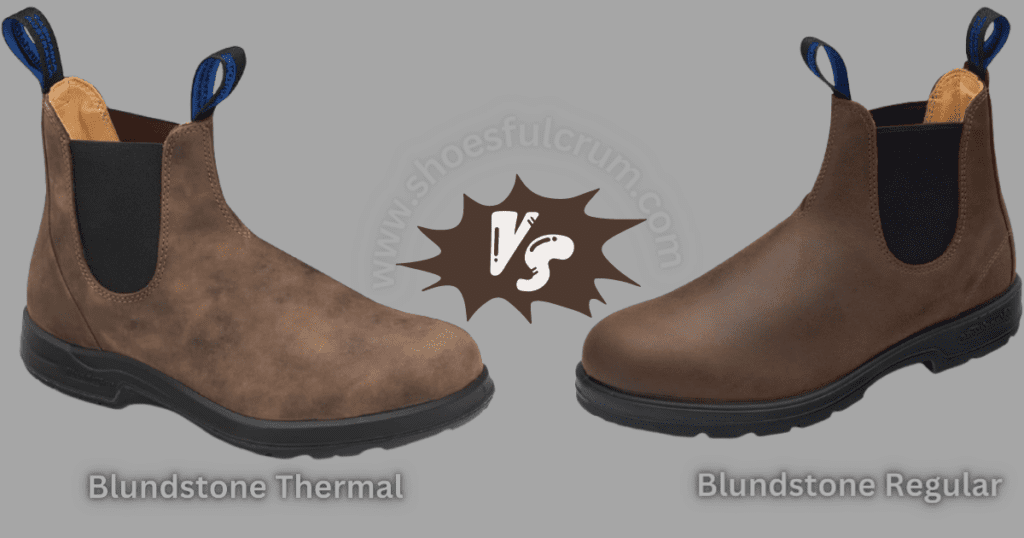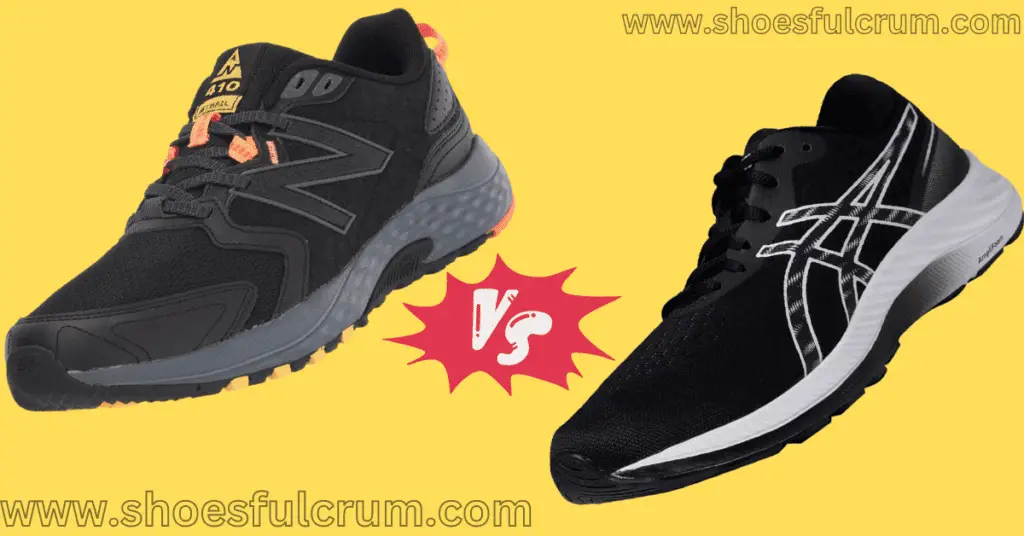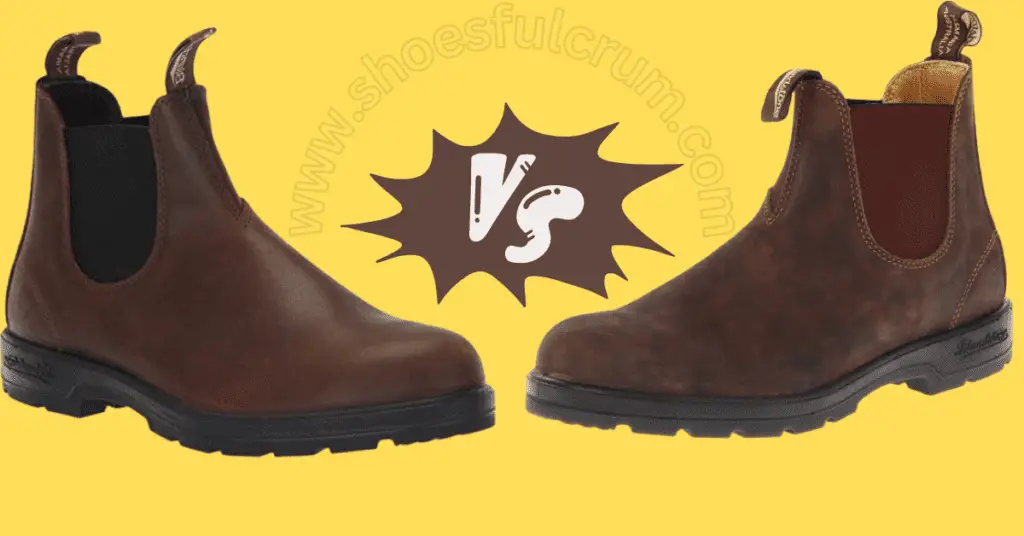The Blundstone Thermal vs Regular boots are popular for those looking for a durable and reliable pair of boots. The key difference between the two is that the Thermal boots are designed to keep your feet warm in colder weather conditions while the Regular Blundstone boots, do not feature any insulation or fleece lining.
Blundstone boots are a type of work boots that are known for their toughness, durability, and comfort. They were first introduced in Tasmania, Australia, in 1870 and have since gained worldwide popularity. Blundstone boots are comprised of high-quality materials like leather and are built to withstand harsh weather conditions.
In this article, I’ll compare two of their most popular models, the Blundstone Thermal and the Regular, and explore which is healthier for your foot.
Comparison Table
To help make the decision-making process easier, here I am providing a detailed comparison table summarizing the key differences between Thermal Boots and Regular Boots.
| Features | Blundstone Thermal Boots | Blundstone Regular Boots |
|---|---|---|
| Insulation | Thinsulate 3M technology for superior warmth in cold conditions. | No specialized insulation; suitable for moderate weather. |
| Temperature Rating | Comfortable in extremely cold temperatures, typically rated to -40°C (-40°F). | Suitable for mild to moderate temperatures; not designed for extreme cold |
| Waterproof | Yes, fully waterproof construction. | Yes, water-resistant but not fully waterproof. |
| Upper Material | Premium water-repellent leather with sealed seams | Premium water-resistant leather with some sealed seams. |
| Lining Material | Soft fleece lining for added warmth and comfort. | Breathable fabric lining |
| Outsole | Thermo-urethane outsole for excellent traction in icy conditions | Durable rubber outsole with decent traction. |
| Purpose | Ideal for extreme winter activities like snowshoeing and winter hiking. | Versatile for everyday wear and light outdoor activities. |
| Weight | Slightly heavier due to the insulation material. | Relatively lighter and more flexible. |
| Style Options | Limited color and style choices | A wide range of colors and designs are available |
| Recommended for | People living in extremely cold climates or winter adventurers. | Individuals in regions with milder winters. |
| Maintenance | Requires occasional cleaning and conditioning to maintain leather | Requires occasional cleaning to preserve the appearance |
Features Of Blundstone Thermal Vs Regular Boots
Both boots have the following features.
Thermal Boots
- The Thermal boots include a layer of Thinsulate insulation to keep your feet warm in cold weather.
- The boots also include a soft and cozy fleece lining, which adds another layer of warmth and comfort.
- The Thermal boots are made of high-quality waterproof leather, which keeps your feet dry in damp weather.
- The boots contain a removable insole that can be replaced with your own orthotics if necessary.
- The Thermal boots have a slip-resistant sole that gives excellent traction on slippery surfaces.
Regular Boots
- Regular Blundstone boots are built for comfort and durability.
- They have a shock-absorbing sole that gives your feet exceptional support, as well as an ergonomic footbed that fits the curve of your foot.
- The elastic side panels provide a snug, comfortable fit, and the pull tabs make them easy to put on and take off.
- They’re also light and breathable, making them ideal for all-day wear.
If your Blundstone Boot do squeaking then read this article “How To Stop Shoes From Squeaking On The Tile? (7 Methods)“
Materials Used
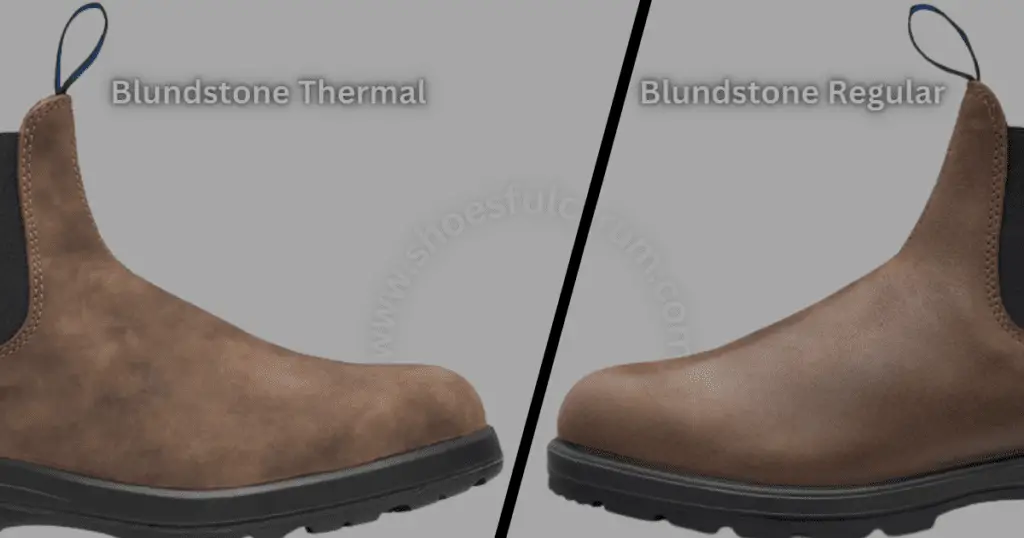
Both Blundstone Boots are made with high-quality materials such as:
Thermal Boots
- The boots are composed of high-quality leather that has been waterproofed.
- The boots have a layer of Thinsulate insulation, which is a form of synthetic insulation known for its warmth and lightweight qualities.
- The boots include a soft and cozy fleece lining that gives an extra layer of warmth and comfort.
Regular Boots
- The regular Blundstone boots are made of high-quality materials such as leather and suede uppers, synthetic soles, and elastic side panels.
- The leather and suede have been treated to be water-resistant, making them appropriate for wearing in damp or rainy environments.
Ideal Conditions for Wearing These Boots?
Both boots perform well in their ideal conditions
Thermal Boots
- The Blundstone Thermal boots are great for cold weather, especially if you plan on spending a lot of time outside.
- They are ideal for hiking, snowshoeing, and other activities that require warmth and comfort.
- Yet, because of the insulation and fleece lining, they may not be the greatest choice for warmer weather conditions.
Regular Boots
- The Blundstone boots are appropriate for a wide range of conditions and activities.
- These are ideal for everyday wear, such as errands or going to work.
- As long as the weather is not too cold or rainy, they are also excellent for mild hiking or outdoor activities.
- They are not suitable for strenuous hikes or in adverse weather.
Comfort Of Blundstone Thermal vs Regular
- The Thermal and Regular boots are both designed to provide a comfortable fit.
- The Regular boots’ elastic side panels and the Thermal boots’ Thinsulate insulation and fleece lining give a snug fit around the foot.
- The Thermal boots, on the other hand, may feel heavier and less breathable, which may result in sweaty feet in hotter temperatures.
Durability
- The Thermal and Regular boots are both made to last, with high-quality materials used in their construction.
- The leather uppers of the Regular boots and the waterproof leather of the Thermal boots are both long-lasting and can handle daily use.
- The boots have slip-resistant soles that provide good traction and are incredibly durable.
Insulation
- The Thermal boots have Thinsulate insulation and fleece inside, making them excellent for cooler weather.
- Regular boots, may not provide enough insulation for colder temperatures but are appropriate for mild to moderate weather.
Water Resistance
- The leather uppers of both the Thermal and Regular boots have been coated to repel water, making them water-resistant.
- The Thermal boots are more suited for rainy weather due to their waterproof leather construction, which provides higher moisture protection.
Traction
- Slip-resistant soles on both the Thermal and Regular boots provide good traction on a range of surfaces.
- The Thermal boots may provide better traction on slippery surfaces due to their more aggressive tread pattern.
Style
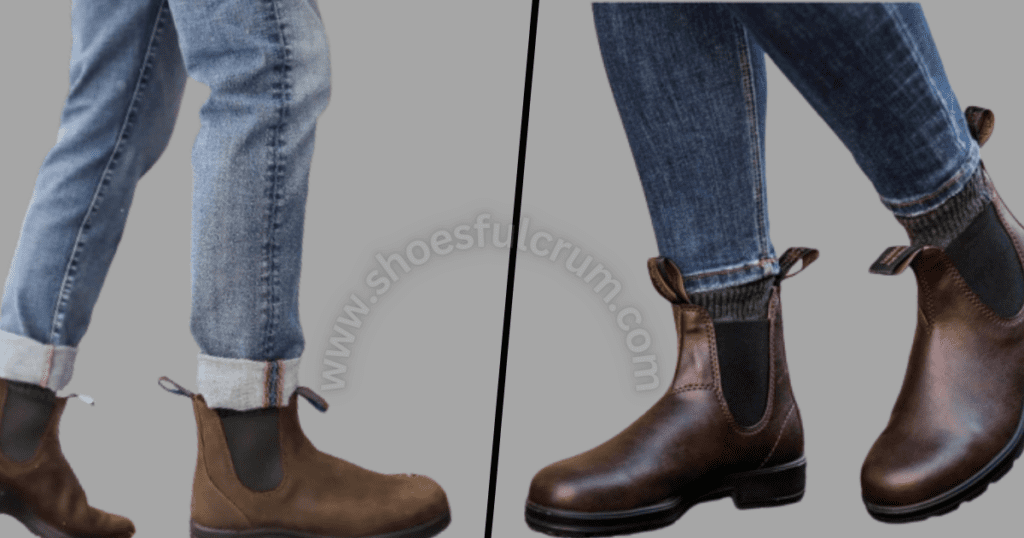
- Regular boots offer a traditional, adaptable design that may go with a variety of outfits.
- The Thermal boots have a more robust, outdoorsy appearance and may be more suitable for outdoor activities.
- Both boots are available in a number of colors and finishes to accommodate a wide range of preferences.
Price
- Due to the increased insulation and waterproof design, Thermal boots are often more expensive than Regular boots.
- Yet, both boots are reasonably priced when compared to other high-quality boots on the market.
Sizing
- The Thermal and Regular boots are both available in a variety of sizes, with half sizes available for a more exact fit.
- However, some users have noted fitting concerns, with the boots being too narrow or too wide for their feet.
Lining
- The Thermal boots are lined with a warm fleece, whereas the Regular boots are lined with a plain fabric.
- In colder weather, the fleece lining of the Thermal boots adds warmth and comfort.
Footbed
- The Thermal and Regular boots both have an ergonomic footbed that provides good foot support.
- The replaceable footbeds make cleaning and replacement simple.
User Feedback
- Users have given the Thermal and Regular boots positive feedback, with many praising their comfort, durability, and style.
- However, some people have noticed sizing and fit concerns, so it’s recommended to try on the boots before purchasing.
Overall, the Thermal boots may be a better choice if you need a warm and waterproof boot for colder weather conditions. Yet, if you’re searching for a versatile, everyday boot, Regular boots are a terrific choice.
Factors To Consider Before Buying Blundstone Boots
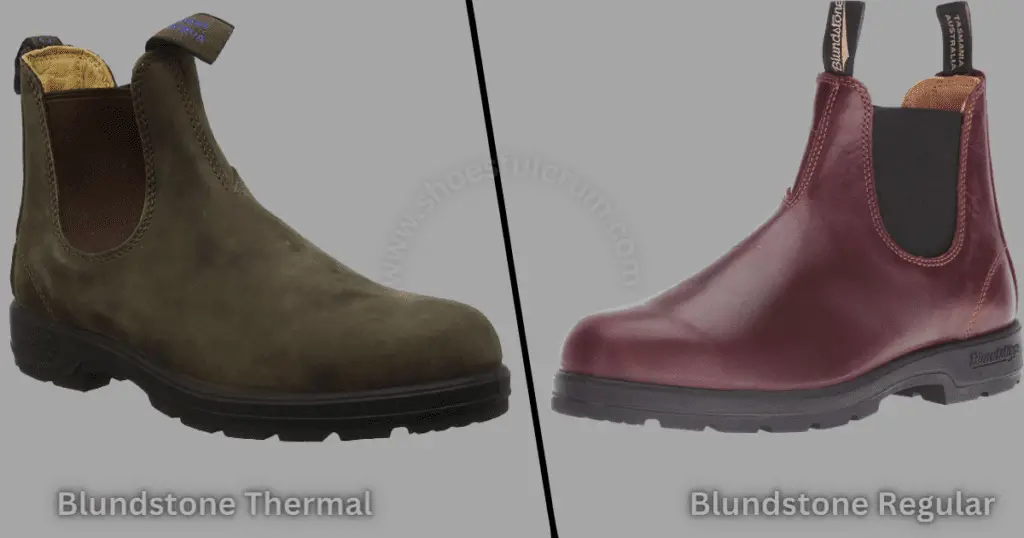
When it comes to Blundstone boots, there are various factors to consider before making your ultimate decision. Climate, the purpose of the boots, foot size, and shape, budget, personal preference, and comparison with other boots on the market are all factors to consider.
Climate
- While selecting a pair of Blundstone boots, consider the climate in your area.
- If you live in a cold or rainy climate, you might want to try Thermal boots for increased warmth and waterproofing.
- If you live in a milder environment, Regular boots may be a better option.
The Purpose Of Boots
Consider how you intend to wear the boots. Are they for business, casual wear, or outdoor activities? Blundstone boots are made for certain reasons, so choose the one that best suits your requirements.
Foot Size And Shape
- It is essential to think about your foot size and shape when selecting any footwear to achieve a good fit.
- Blundstone boots are available in a variety of sizes, including half sizes for a more accurate fit.
- They also come in a variety of widths, so make sure to get the perfect one for your foot shape.
Budget
- Blundstone boots are reasonably priced, but prices might vary based on style and features.
- When making a purchase, determine your budget and analyze the features and durability you’re getting for the price.
Personal Preference
- When selecting a pair of boots, personal preference is quite important.
- Evaluate the color, design, and finish that best complements your personal style and wardrobe.
- Consider the type of closure you want, as Blundstone boots are available in both lace-up and slip-on designs.
In Comparison To Other Markets Boots
- Finally, it is important to compare Blundstone boots to other brands on the market.
- Compare the features, durability, and price of other brands and models.
- This will allow you to make an informed decision and get the most out of your money’s worth.
Considering these factors will help you in selecting the best pair of Blundstone boots to fit your demands and preferences.
Pros And Cons
Despite their features and ideal conditions, both thermal and regular boots also have pros and cons.
Blundstone Thermal Boot
| Pros | Cons |
|---|---|
| Warmth | Bulky |
| Waterproof | Limited breathability |
| Slip-resistant | |
| Durable | |
| Easy on and off |
Blundstone Regular Boot
| Pros | Cons |
|---|---|
| Versatility | Not best for wider feet or high arches |
| Suitable for light hiking | Not warmth |
| Durable | |
| Excellent support | |
| Easy to put on and takeoff |
If you want to know about Blundstone Antique Brown vs Rustic Brown then read this article “Blundstone Antique Brown VS Rustic Brown: Which Is Better?“
Conclusion
Blundstone Thermal Vs Regular Boots ultimately comes down to personal preference because if you are looking for cold weather boots consider thermal boots and if you are looking for casual wear then consider regular boots.
Moreover, Blundstone boots have a variety of characteristics that cater to various demands and preferences. Blundstone boots are versatile and can be worn in a variety of weather conditions, however, some styles may not be ideal for specific activities, such as hiking.
It is also important to correctly break in the boots and consider resolving them if needed. Blundstone boots come with a warranty that covers manufacturing defects for a specified period of time.
Overall, Blundstone boots are a popular and reliable choice for people looking for comfortable, sturdy, and attractive boots for a variety of occasions.
FAQ’s
Are Blundstone Thermal boots waterproof?
Blundstone Thermal boots are water-resistant, which means they can handle mild rain and splashes. They are not totally waterproof, however, and should not be submerged or worn in severe rain or deep puddles.
How do I determine my Blundstone size?
Blundstone boots normally run true to size, but it’s always a good idea to measure your foot and compare it to the size chart before purchasing. Stand on a sheet of paper and trace the contour of your foot to measure it. Measure the length from the heel to the longest toe and compare it to the Blundstone size chart.
What is the lifespan of Blundstone boots?
Blundstone boots are known for their toughness, and with proper care and maintenance, they can last for years. The boots’ longevity is determined by factors such as usage, climate, and how well they are cared for.
Is it okay to wear Blundstone boots in the summer?
Blundstone boots can be worn in the summer, however, they may not be as comfortable as in the winter. In warm weather, leather boots can get hot and sweaty. However, the Blundstone Classic and Formal boots, include a breathable lining that can help keep your feet cool.
How should I care for my Blundstone boots?
Use a soft-bristled brush or a moist towel to remove any dirt or debris from your Blundstone boots. Harsh chemicals and detergents should be avoided since they can harm the leather. Instead, use a gentle soap and water solution or a leather cleaner. Wipe the boots dry with a clean cloth after cleaning.
Can I wear my Blundstone boots outside in the snow?
Blundstone boots are not intended for use in heavy snow or in extreme cold. The Blundstone Thermal boots, on the other hand, are water-resistant and insulated, making them perfect for light snow and cooler weather. It should be noted that the boots are not entirely waterproof and should not be worn in deep snow or slush.
Are Blundstone boots appropriate for hiking?
Blundstone boots are not specifically designed for hiking, but they are tough and sturdy enough for light hiking and outdoor sports. The boots feature a slip-resistant sole that provides excellent traction on uneven terrain. But, if you intend to perform more serious hiking, you should invest in a pair of hiking boots.
What should I do to break in my Blundstone boots?
Blundstone boots are made to mold to your feet over time, however, they may take some time to break in. Wear your boots for brief amounts of time initially, gradually increasing the amount of time you wear them. You can also apply a leather conditioner to soften and stretch the leather.
Is it possible to resole my Blundstone boots?
A professional cobbler can resole Blundstone boots. The boots’ soles are sewn to the upper, making it simple to replace them as they wear out. However, resoling may violate the boots’ guarantee.
What is the Blundstone boot warranty?
All Blundstone boots come with a 2-year limited warranty. The guarantee covers material and workmanship faults, but not regular wear and use, misuse, or damage caused by poor care or storage. You must show evidence of purchase and contact the Blundstone customer care team to file a warranty claim.

About Author:
Hammad Qadir is a passionate fashion blogger with a passion for shoes, spanning over seven years. As the driving force behind “ShoesFulcrum.com” he offers unparalleled insights into iconic brands like Crocs, Hey Dude, and Birkenstock. With a collection of a hundred pairs, his expertise extends to industry giants like Nike and Adidas. Through insightful reviews and recommendations, Hammad guides readers to their perfect pair. Hammad’s knack for differentiating between brands and guiding readers makes him a trusted authority. Active on Quora, Reddit, Medium, LinkedIn, and Pinterest, he fosters engagement and shares exclusive content. Read more...

